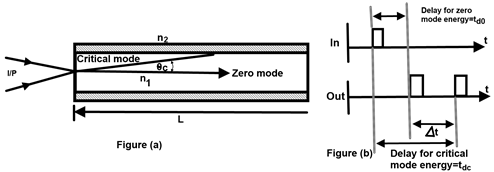Dispersion
The pulse broadening effect is called dispersion
Or
The effect that causes the output pulse to be wider than the input pulse is called dispersion.

This figure verifies the effect of dispersion. When the signal or pulse of light travels in a fiber than it becomes wider because of various propagation phenomena.
By dispersion the output light pulse width produces from an idealized input pulse of nearly zero width.
Let us say tp1 = width of input pulse
tp2 = width of output pulse
So tp2> tp1due to dispersion
The dispersion is denoted by
The dispersion is measured in units of time typically in nanoseconds (10-9 sec). The dispersion of a fiber deeply depends on fiber length. A longer fiber causes more broadening or dispersion, that is why the dispersion of any particular fiber is specified by manufacturer as “dispersion per unit length”, typically ns/km or ps/km.
Now for a given length of fiber, we can easily calculate the total dispersion by formula. i.e.
∆t = L X (dispersion/km)
Types of dispersion
The dispersion can be divided into two general categories. i.e.
- Internal dispersion
- Intro model dispersion
Inter model dispersion
The dispersion which is caused by the delay between different modes is called inter model dispersion.
Or
It is dispersion between the modes, caused by difference in propagation time for different modes.
Let us consider two extreme modes propagating along the fiber axis shown as:

In figure (a) the critical mode propagating at angle θc and another mode is zero mode because here propagation angle is zero.
A pulse of light lunched into the fiber will propagate along the fiber in both modes.
- For mode 0, travel time will be minimal and can be expressed by
td0 = L/(c/n1)
td0 = L (n1 / c) ---------- (1) Min: Propagation delay
where
L = fiber length
n1 = core refractive index
c/n1 = Speed of light in fiber - For ray traveling at angle θc , the delay will be maximum and can be expressed by.
tdc = (L/Cosθc )/ (c / n1 )
tdc = (L/ Cosθc )(n1/c)
tdc = Ln1 / C Cosθc ------------ (2) Max: Propagation delay
The difference between shortest delay (td0) and largest delay (tdc) is the time during which pulse energy will arrive at the fiber output, which represents the pulse width at output.
So
Pulse width = ∆t = tdc – td0 put from (1) and (2)
Where n1 = refractive index of core
.. n2 = refractive index of cladding
Since ∆= (n1 – n2)/n2 = relative refractive difference.
Now for ∆ << 1, the denominator can be n1 or n2
Therefore put in (3)
This is the equation for amount of pulse broadening in terms of N.Aperture
For broadening per unit length of fiber eq. (5) becomes
Intra Model Dispersion
The dispersion which is independent of modes, related to the line width (∆λ) of the source and caused by variations in the refractive index as a function of wave length is called intra model dispersion.
Since intra model dispersion depends on line width which is related to color. Therefore it is also called chromatic dispersion (color dependent dispersion).
When we increase the line width (∆λ) than it increases the dispersion. Note that this dispersion is given in terms of “Pico second per kilometer per nanometer of line width”.
We know that the light velocity in a fiber varies with λ if the line width is 820 -> 850 nm (∆λ = 30nm) than 820nm part of the pulse energy is slower than the 850nm part, producing the pulse broadening effect.
For a source with λ above about 1.3µm, the situation is reversed. If the line width is 1320 to 1350 nm (∆λ = 30nm) than 1320nm part of pulse energy is faster than 1350nm part, which is also produce the pulse broadening effect.
For a small ∆λ near λ = 1300nm, the shorter and longer wave lengths travel at about the same velocity. This leads to minimal intra model dispersion at λ = 1300nm (or 1.3µm).
From different causes, the total dispersion is found
